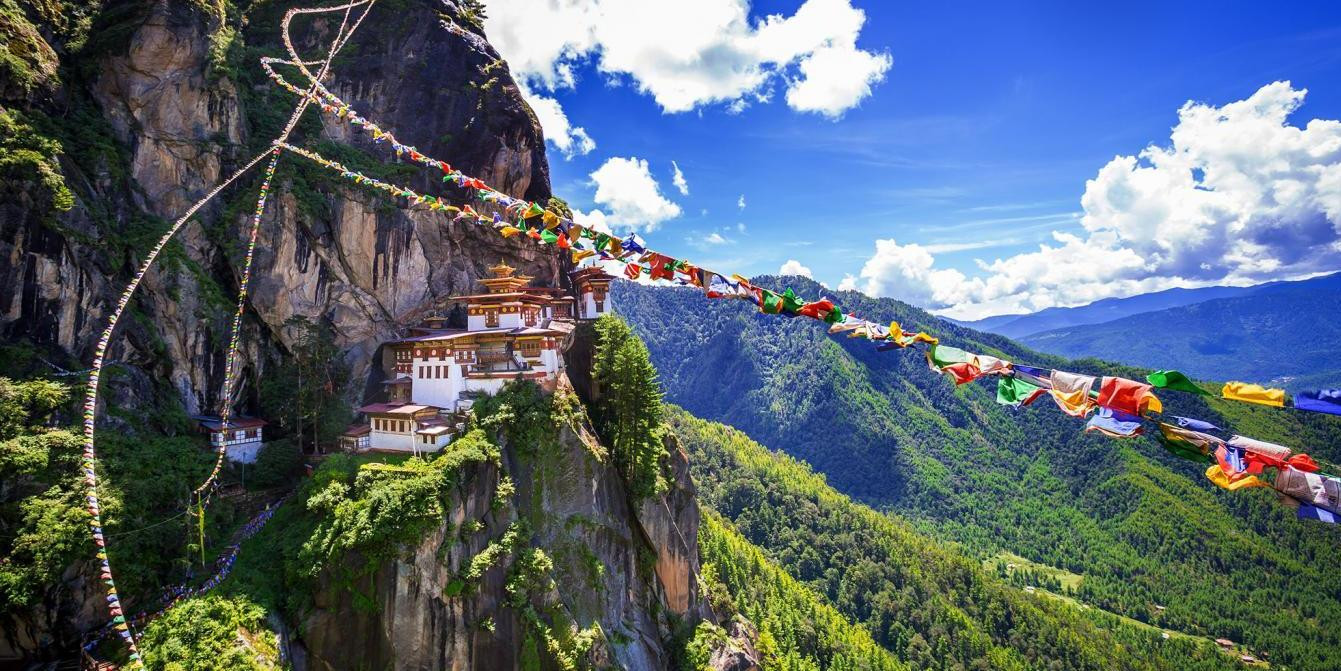Panoramic Mountain Vistas
Bhutan’s panoramic mountain vistas are among its most awe-inspiring attractions, offering visitors breathtaking views of the majestic Himalayas. These landscapes are not only a feast for the eyes but also provide a serene backdrop that enhances the peaceful ambiance of the country. Here are some of the best spots to experience these stunning views:
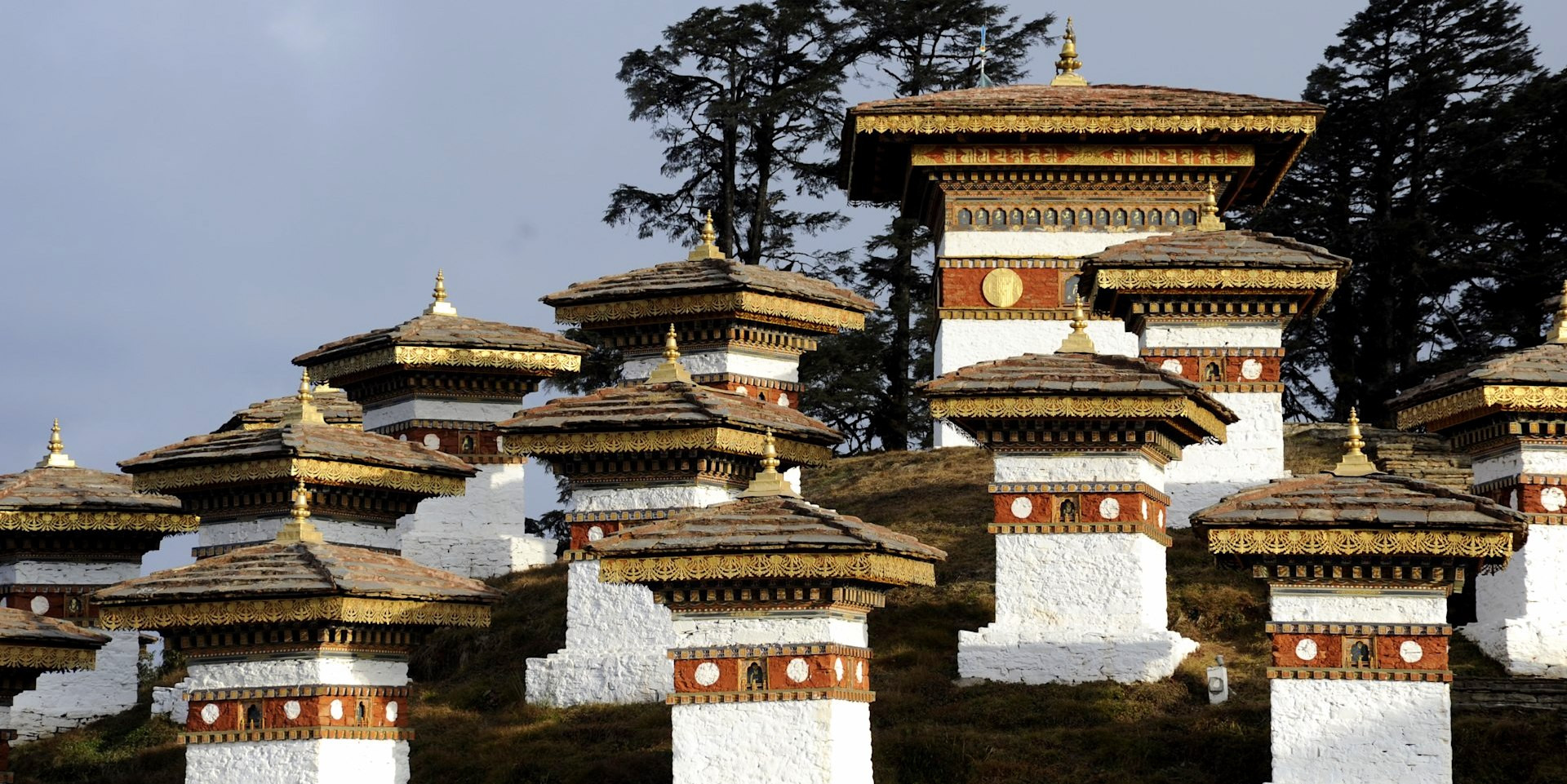
-
Dochula Pass: Located on the way from Thimphu to Punakha, Dochula Pass offers a spectacular 360-degree panoramic view of the Himalayan mountain range. On a clear day, you can see a series of peaks stretching across the horizon, including the famous Gangkar Puensum, which is the highest unclimbed peak in the world.
-
Chele La Pass: At over 3,800 meters, Chele La is the highest road pass in Bhutan, linking the valleys of Paro and Haa. The pass provides breathtaking views of Mount Jomolhari, Jichu Drake, and other sacred summits. The area is also known for its vibrant rhododendron forests, adding a splash of color to the landscape.
-
Paro Valley: This broad valley offers stunning mountain scenery and is home to some of Bhutan’s oldest temples and monasteries, as well as the country’s only international airport. The verdant valley floors starkly contrast with the rugged mountains that surround them, creating picturesque views from every angle.
-
Bumthang Valley: Often considered Bhutan's spiritual heartland, Bumthang comprises four major valleys with wide, scenic vistas surrounded by mountains. The area’s numerous ancient temples and sacred sites are set against a backdrop of rolling hills and rivers, making it a visually and spiritually enriching experience.
-
Tiger’s Nest Monastery (Paro Taktsang): While the journey up to the Tiger’s Nest is a trek in itself, the views from this iconic monastery are unmatched. Perched on a cliff 900 meters above the Paro Valley, the monastery offers panoramic views that are both dramatic and inspiring.
These mountain vistas attract tourists from around the world and serve as daily reminders of Bhutan’s natural beauty and the deep cultural reverence the Bhutanese have for their environment.
Peaceful and calm Atmosphere
Bhutan is renowned for its peaceful and calm atmosphere, a defining characteristic that sets it apart from many other tourist destinations. This tranquility is deeply rooted in the country’s Buddhist culture and its national philosophy of Gross National Happiness, which prioritizes the well-being of its people and the preservation of its natural and cultural heritage.
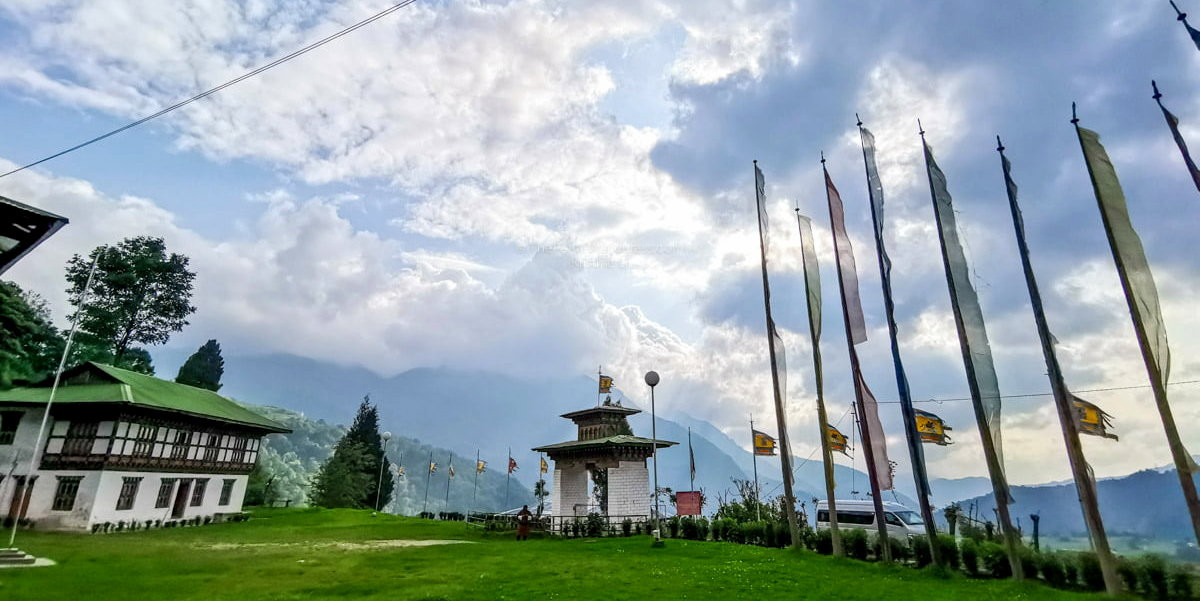
Here’s how Bhutan maintains its serene atmosphere
-
Limited Tourism Impact: Bhutan's unique approach to tourism, which involves a minimum daily fee for all tourists, helps control the number of visitors to the country. This not only prevents overcrowding but also ensures that tourist activities do not disrupt the local way of life, maintaining a peaceful environment for both locals and visitors.
-
Natural Landscapes: Surrounded by the towering Himalayas and lush, pristine forests, Bhutan's natural environment contributes significantly to its calmness. The presence of green spaces, the sound of flowing rivers, and the clean, fresh air all combine to create a setting that naturally soothes the mind and body.
-
Spiritual Orientation: With a strong spiritual heritage, many Bhutanese engage in daily practices of meditation and mindfulness, contributing to a collective sense of peace. Monasteries, temples, and prayer flags are common sights, and the sounds of prayer and meditation often fill the air, reinforcing the spiritual ambiance that permeates the country.
-
Community and Lifestyle: Bhutanese society is closely knit, with strong community ties and a lifestyle that emphasizes simplicity and traditional values. The pace of life here is generally slow and unhurried, which greatly contributes to the overall atmosphere of calm. Social gatherings and community events are often centered around temples and monastic celebrations, which are spiritual and tranquil in nature.
-
Regulated Modernization: While Bhutan has embraced certain aspects of modernity, it has done so on its own terms and at its own pace, ensuring that technological and economic developments do not undermine the cultural integrity or the tranquility of the country. For instance, Thimphu is one of the few world capitals without traffic lights, which symbolically highlights Bhutan's approach to maintaining a calm and measured pace of life.
This peaceful and calm atmosphere not only makes Bhutan a unique place to visit but also a source of inspiration for visitors from more hectic societies, offering them a chance to unwind, reflect, and reconnect with nature and spirituality.
Rich Cultural Heritage
Bhutan's rich cultural heritage is a tapestry woven with traditions, rituals, and a deep reverence for its Buddhist beliefs. This profound cultural identity shapes every aspect of life in Bhutan, from architecture to everyday customs, and is passionately preserved by its people amidst the currents of modernization.
Here are key elements that exemplify Bhutan's rich cultural heritage
-
Architecture: Bhutanese architecture is distinctly unique, with no parallel anywhere else in the world. Traditional buildings, including homes, monasteries, and fortresses known as dzongs, feature intricately carved wooden beams, sloping walls, and large, decorated windows without the use of a single nail in their construction. This architectural style is not only aesthetically striking but also reflects Bhutanese spiritual values, as most structures are adorned with religious symbols and motifs.
-
Dress Code: The national dress, mandatory for all Bhutanese in public areas, is a testament to Bhutan's cultural preservation. Men wear the 'gho', a knee-length robe tied at the waist by a traditional belt called 'kera', and women wear the 'kira', an ankle-length dress accompanied by a light outer jacket known as a 'tego'. This dress code fosters a strong sense of national identity and pride.
-
Festivals: Bhutan's cultural calendar is rich with religious festivals known as 'tshechus', which are held in various dzongs across the country. These festivals feature mask dances ('cham'), religious plays, and rituals that are believed to confer blessings upon the spectators. Tshechus are vibrant, colorful displays of Bhutanese culture, with the most famous being the Paro and Thimphu Tshechus.
-
Language and Literature: Dzongkha, the national language, is an integral part of Bhutanese identity. Classical Bhutanese literature is predominantly religious, though in modern times there has been a move towards documenting Bhutanese folklore, myths, and legends which were traditionally transmitted orally.
-
Religious Practices: Buddhism is not just a religion but a way of life in Bhutan. The landscape is dotted with stupas, prayer wheels, and flags, which the locals believe help spread spiritual blessings. Monks are highly respected and play a crucial role in the community, providing guidance and education.
-
Art and Crafts: Bhutanese art is deeply religious, with paintings, sculptures, and textiles often embodying Buddhist themes. Thangka paintings, intricate wood carvings, and vibrant textiles such as the hand-woven 'gho' and 'kira' showcase the skill and spiritual devotion of Bhutanese artisans.
-
Cuisine: Bhutanese cuisine also reflects its cultural heritage, featuring unique ingredients like chili and cheese, which are staples in many dishes. Meals are typically communal, reflecting the country's community-oriented culture.
This rich cultural heritage not only adds to the mystique and allure of Bhutan as a travel destination but also represents a living culture that the Bhutanese actively preserve and cherish, offering a profound experience for visitors from around the world.
Festivals and Traditions
Bhutan's vibrant festivals and deeply rooted traditions form an integral part of its cultural identity, reflecting the spiritual depth and historical richness of this Himalayan kingdom. Celebrations are not only a spectacle of color and joy but also serve as spiritual occasions and a means of passing down Bhutanese values and history from one generation to the next.
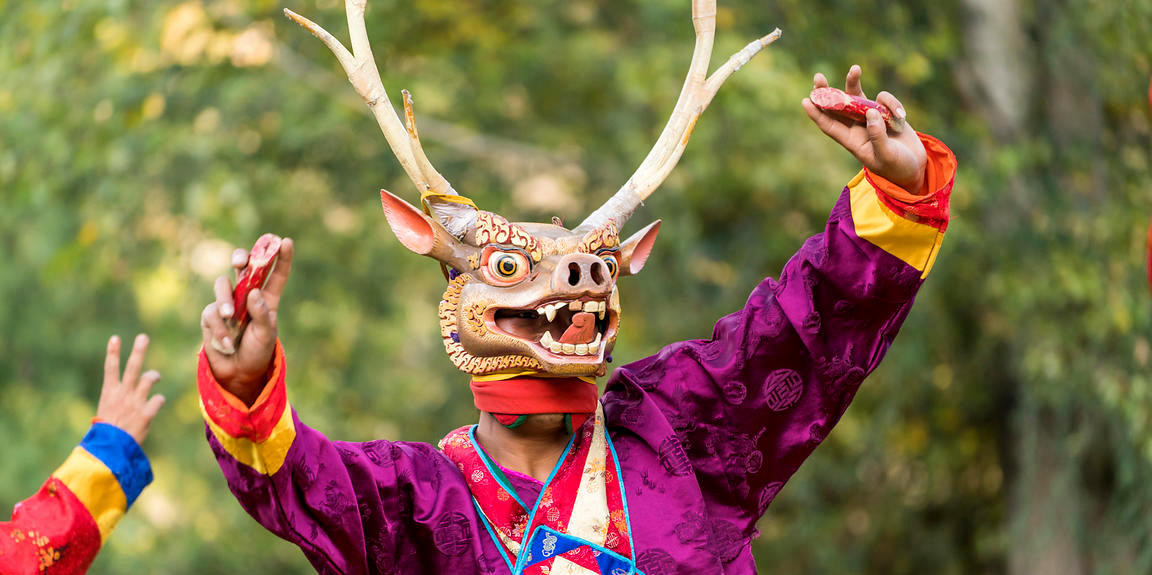
Festivals in Bhutan: Tshechus are the most prominent festivals in Bhutan, celebrated in every district or dzongkhag of the country. These religious festivals are held on auspicious days and months in the Bhutanese calendar and are dedicated to Guru Rinpoche, who brought Buddhism to Bhutan. Here are some notable features of Tshechus:
-
Masked Dances: Known as Cham dances, these are performed by monks and laymen wearing elaborate silk costumes and masks depicting deities, demons, and animals. Each dance narrates a story from Buddhist mythology, often depicting the triumph of good over evil.
-
Religious Music: Traditional music played on drums, horns, and bells accompanies the dances, enhancing the spiritual ambiance.
-
Spiritual Significance: Attending a Tshechu is believed to be a spiritually meritorious act, providing the community with blessings and protection from misfortune.
Paro Tshechu and Thimphu Tshechu are the most famous, attracting thousands of locals and tourists. These events provide a glimpse into the soul of the Bhutanese way of life, with festivities lasting several days.
Traditional Bhutanese Customs
-
Archery: The national sport of Bhutan, archery competitions are a common feature at many social gatherings, accompanied by much camaraderie and festivity. Competitions are festive events with traditional music, dancing, and a good-natured exchange of taunts.
-
Community Involvement: Traditional life in Bhutan is community-oriented. Events like local markets, religious gatherings, and the construction of homes or community projects are done together, reflecting the communal spirit of the Bhutanese people.
-
Marriage and Family Rituals: Traditional weddings in Bhutan are elaborate multi-day affairs, involving intricate rituals to bring luck and happiness to the couple. Similarly, birth and naming ceremonies are important traditions, with specific rituals performed to ensure the child's future well-being.
Traditional Attire: The importance of traditional attire such as the Gho for men and Kira for women, worn during these festivals and daily life, reinforces a sense of identity and continuity. This dress code is strictly observed, especially during official functions and religious occasions, underscoring the deep respect for tradition that permeates Bhutanese society.
Spiritual Practices: The everyday spiritual practices of the Bhutanese, like prayer flag hoisting, turning prayer wheels, and morning and evening prayers, integrate their religious beliefs seamlessly into daily life, adding to the spiritual atmosphere that characterizes the country.
These festivals and traditions are not only occasions for joy and celebration but also play a crucial role in safeguarding Bhutan's cultural heritage. They offer visitors a profound insight into the Bhutanese way of life, making their travel experience truly unique and enriching.
Bhutanese Cuisine
Bhutanese cuisine is as unique and vibrant as the country itself, deeply influenced by its Buddhist culture and Himalayan environment. The food in Bhutan is known for its spiciness and the heavy use of local ingredients, which makes every meal an exciting culinary adventure. Here's a closer look at the essential aspects of Bhutanese cuisine:
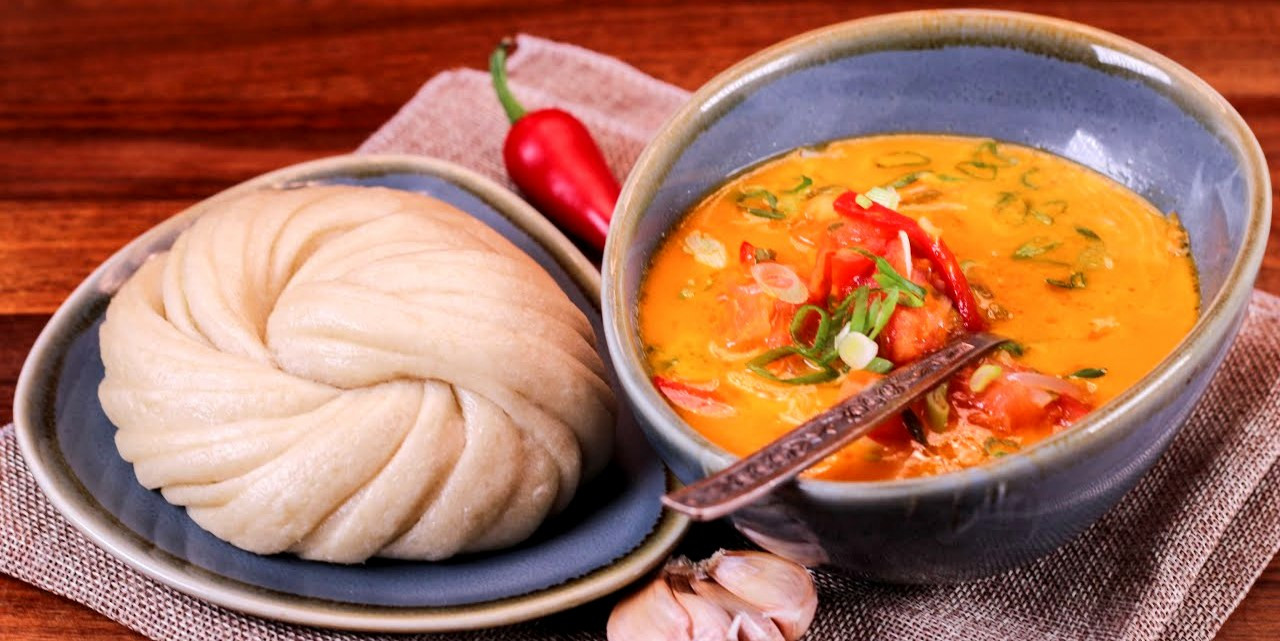
Staple Ingredients
-
Chili: Unlike most other cuisines where it is used sparingly, chili is the main ingredient in many Bhutanese dishes, sometimes even treated as a vegetable rather than a spice.
-
Cheese: Homemade cheeses, often from cow or yak milk, are common and used in various dishes, adding a creamy texture and rich flavor.
-
Red Rice: A Bhutanese specialty, this nutty-flavored whole grain is grown in the Paro Valley and is a common accompaniment to most meals.
Iconic Dishes
-
Ema Datshi: This is the national dish of Bhutan, a spicy stew made from chili and cheese (ema means chili, and datshi means cheese in Dzongkha). There are variations of this dish, including Kewa Datshi (potato and cheese) and Shamu Datshi (mushrooms and cheese).
-
Jasha Maroo or Maru: A spicy chicken stew that is flavored with ginger, garlic, and onions, and served with red rice.
-
Momo: Tibetan-style dumplings that are very popular in Bhutan, filled with pork, beef, or cabbages and cheese.
Beverages
-
Butter Tea: A Bhutanese staple, this is made from tea leaves, butter, and salt. It's an acquired taste for many but is a significant part of Bhutanese hospitality and daily diet.
-
Ara: A traditional alcoholic beverage distilled from rice, corn, wheat, or barley. It is often homemade and served during special occasions and gatherings.
Eating Habits and Customs
-
Communal Eating: Meals are typically served family-style, with everyone sharing from common dishes. This practice reinforces social bonds and family ties.
-
Hospitality: Offering food is a sign of hospitality in Bhutanese culture, and refusing it is considered impolite. Guests are often welcomed with a small snack or tea, regardless of the hour.
Local Influence
- The use of local, fresh ingredients is integral to Bhutanese cooking. The geographical isolation of many communities has led to a reliance on locally sourced produce, which supports sustainability and gives Bhutanese cuisine its distinctive freshness.
Health Aspects
- Bhutanese meals are often balanced with a good mix of carbohydrates, proteins, and fats, heavily leaning on vegetables and meats. The liberal use of chilies and spices not only adds flavor but also has metabolism-boosting properties.
Exploring Bhutanese cuisine offers insight into the country’s culture, environment, and traditions. Each meal reflects the Bhutanese people's philosophy of living in harmony with nature, making their food wholesome, satisfying, and a vital part of the travel experience in Bhutan.
Trekking and Adventure
Bhutan, with its unspoiled landscapes and majestic Himalayan ranges, is a paradise for adventure enthusiasts and trekkers. The country offers a wide range of trekking opportunities, from gentle walks through serene valleys to challenging hikes up steep mountain passes. Here’s an overview of the trekking and adventure options in Bhutan, showcasing why it's a top destination for those seeking both thrill and tranquility.
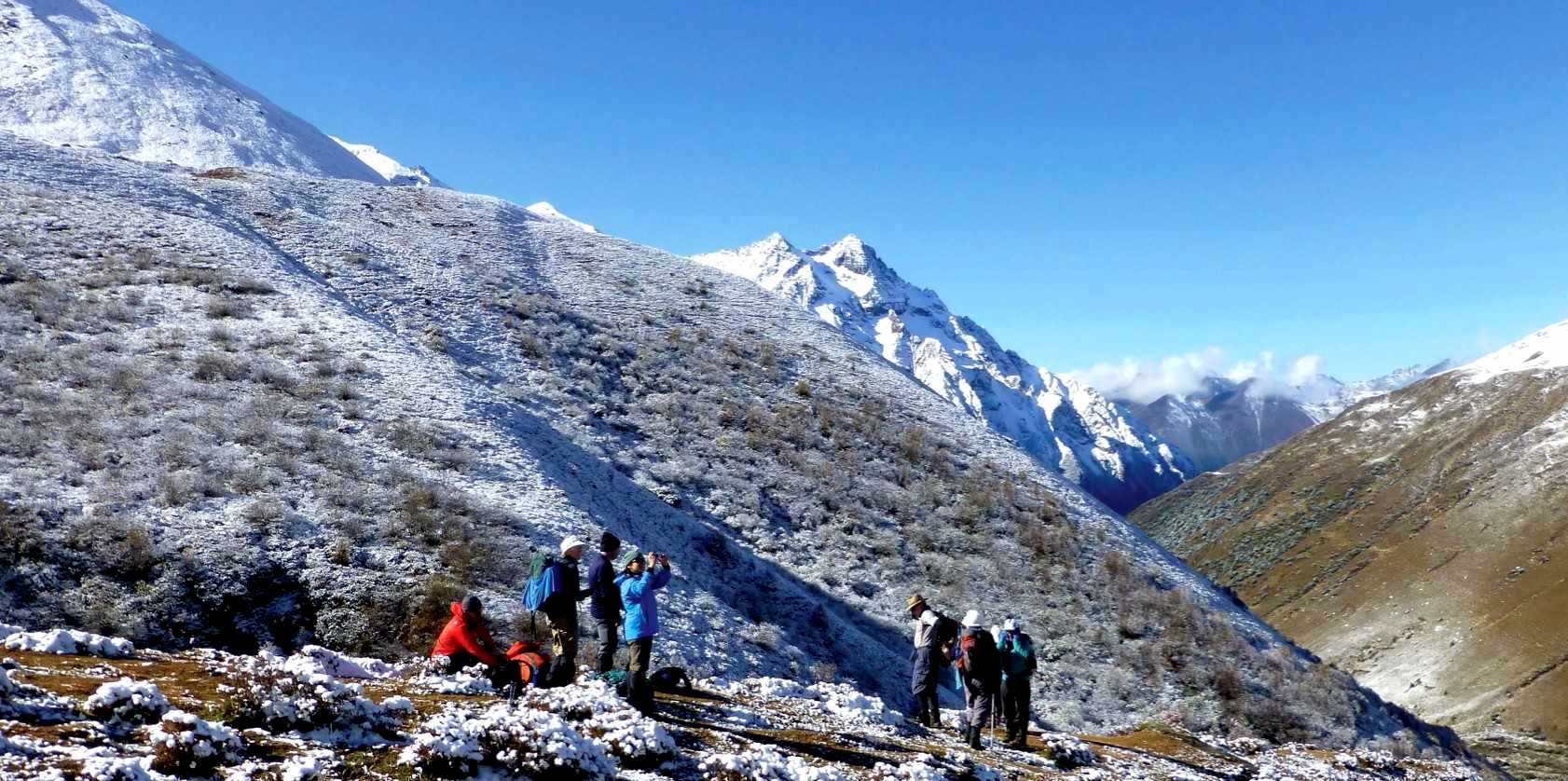
Popular Trekking Routes
-
Jomolhari Trek: Often considered one of the most beautiful treks in Bhutan, the Jomolhari Trek takes you to the base of Mount Jomolhari, standing at 7,326 meters. It’s a challenging route that rewards trekkers with stunning views of pristine landscapes, high mountain passes, and remote villages. This trek also provides an opportunity to witness the rich flora and fauna of Bhutan, including blue sheep and possibly even the elusive snow leopard.
-
Druk Path Trek: This is one of the most popular treks for those who wish to combine cultural sightseeing with moderate hiking. Connecting Paro to Thimphu, the trek passes through a stunning landscape of thick alpine forests, high ridges, and pristine lakes. The path also offers spectacular views of the Himalayas, including Bhutan’s highest mountain, Gangkar Puensum.
-
Snowman Trek: Known as one of the most difficult treks in the world due to its altitude, length, and weather conditions, the Snowman Trek appeals to highly experienced trekkers. It traverses through 11 high passes over 4,500 meters, offering mesmerizing views and a true test of endurance and spirit.
-
Bumthang Cultural Trek: This trek offers a less strenuous walk through the heart of Bhutan, focusing on the country’s rich cultural heritage. It provides a close look at Bhutan’s rural life, ancient Buddhist temples, and monasteries.
-
Gangtey Trek: Ideal for those looking for a short trek, the Gangtey Trek in the beautiful Phobjikha Valley offers a gentle journey through meadows and villages, with an up-close view of the famous Gangtey Monastery.
Sustainable Adventure: Bhutan’s approach to tourism ensures that all adventure activities promote environmental sustainability and cultural respect. The country’s strict tourism policies help preserve its ecological balance and ensure that trekking and other activities have minimal impact on the natural environment.
Preparing for Trekking in Bhutan: When planning a trekking adventure in Bhutan, it’s essential to consider the best seasons, typically spring (March to May) and autumn (September to November), when the weather is clear and dry. It’s also important to be physically prepared for high-altitude hikes and to carry appropriate gear.
Exploring Bhutan through trekking and adventure activities allows visitors to connect deeply with the natural beauty and cultural richness of this secluded Himalayan kingdom, making for an unforgettable experience.
Sustainable Travel
Bhutan is a pioneering nation in sustainable travel, integrating environmental conservation, cultural preservation, and social inclusivity into its tourism model. This commitment is rooted in the country's philosophy of Gross National Happiness, which prioritizes the well-being of both the environment and its people over mere economic growth. Here’s how Bhutan champions sustainable travel:
-
Tourism Regulation: Bhutan employs a unique policy where tourists must pay a minimum daily tariff. This fee covers accommodation, transportation, food, and a local guide. Most importantly, a significant portion of this fee goes directly towards funding free education, healthcare, and poverty alleviation, as well as the conservation of Bhutan's environment. This policy not only limits the number of visitors to prevent over-tourism but also ensures that those who visit contribute positively to the nation’s economy and the preservation of its resources.
-
Environmental Conservation: Bhutan is the world's only carbon-negative country. It absorbs more carbon than it emits, thanks to its vast forests, which cover more than 70% of its land area—a constitutional mandate requires that a minimum of 60% of Bhutan’s land remains under forest cover in perpetuity. Additionally, the country invests in sustainable practices such as organic farming and promotes the use of renewable energy sources, mainly hydroelectric power.
-
Cultural Preservation: Sustainable travel in Bhutan also means the active preservation of its culture. The government enforces dress codes and traditional building regulations that help maintain the cultural landscape. Tourists are also encouraged to engage with local customs respectfully, including participating in local festivals and visiting sacred sites with the understanding that they are to leave no trace behind.
-
Community Engagement: Engagement with local communities is a core part of the travel experience in Bhutan. Visitors often stay in family-run lodges or participate in community-led tours, which directly benefit the local economy. The tourism sector promotes fair employment practices and capacity building among local communities, ensuring that the benefits of tourism are distributed equitably.
-
Challenges and Future Directions: While Bhutan's model of sustainable tourism is commendable, it faces challenges, including balancing increasing tourist interest with conservation and maintaining local culture without it becoming a showcase for visitors. The country continues to adapt its policies to address these challenges, aiming to set a global benchmark for sustainable travel.
-
Why Sustainable Travel Matters: For travelers, choosing Bhutan as a destination means actively participating in a movement that supports sustainable development. It’s about more than just visiting a place; it’s about contributing to its preservation and the well-being of its residents. This approach to travel can provide a more meaningful connection to the destination and a deeper understanding of the impact tourism can have on the world's precious and often vulnerable destinations.
Bhutan’s commitment to sustainable travel preserves its majestic landscapes and rich culture for future generations and offers a model for the world on balancing development with sustainability.
Bhutanese Handicrafts
Bhutanese handicrafts are a vibrant expression of the nation's rich artistic heritage and an integral part of Bhutanese culture. Rooted in Buddhist traditions and made with meticulous care, these handicrafts are not just decorative items but also hold significant cultural and spiritual value. Here's an overview of the traditional crafts that Bhutan is famous for:
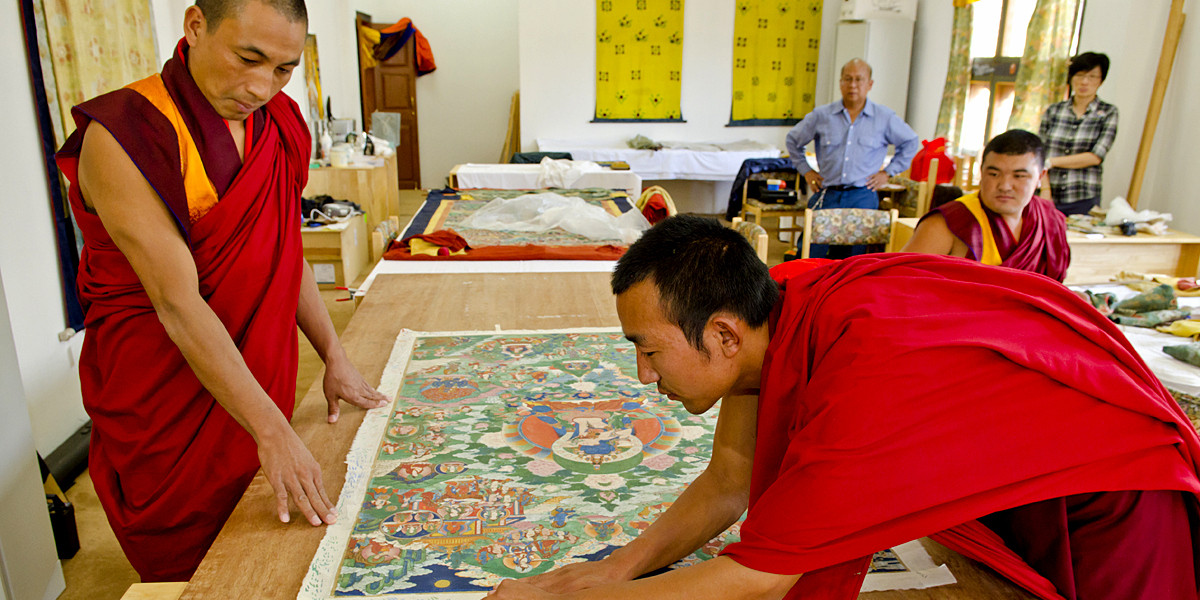
-
Thangka Paintings: One of the most exquisite forms of Bhutanese art, Thangka paintings are religious scroll paintings that depict Buddhist deities, scenes, or mandalas. These are traditionally used in monasteries and households for meditation purposes. Thangkas are painted on cotton or silk appliqué, usually framed with colorful silk brocades.
-
Textiles: Bhutan is renowned for its handwoven textiles, which are considered among the best in the world. The weaving of intricate patterns and designs using silk, cotton, and wool threads is a skill passed down through generations, particularly among women. The rich colors and intricate patterns found in items like the national dress (Gho for men and Kira for women) showcase diverse regional styles and techniques.
-
Woodwork: Wood carving is another traditional craft prominent in Bhutanese architecture and household items. Intricate designs are carved into pillars, doors, and windows of traditional buildings, as well as into bowls, cups, and other utensils. The art of wood carving reflects the high level of craftsmanship that Bhutanese artisans possess.
-
Bamboo and Cane Weaving: Bamboo and cane weaving are widely practiced in Bhutan. These materials are used to make a variety of goods, including baskets, mats, containers, and traditional hats. The flexibility and availability of bamboo and cane make them popular materials for crafting durable and functional items.
-
Pottery: Pottery making is an ancient craft in Bhutan, traditionally centered in the village of Ongdi. Pottery items are typically unglazed and fired using traditional methods. While this craft is less prevalent today, efforts are being made to revive it as part of Bhutan’s cultural preservation.
-
Jewelry: Bhutanese jewelry, often made from silver, gold, and precious stones, is deeply symbolic. Traditional designs frequently include religious symbols and motifs believed to offer protection and blessings to the wearer. Bhutanese artisans are known for their skill in creating intricate metalwork that reflects the spiritual and aesthetic values of their culture.
-
Blacksmithing: The art of blacksmithing is still practiced in some rural areas of Bhutan, where traditional methods are used to produce agricultural tools, religious items, and weapons. This craft is respected for its importance to daily life and its historical significance.
-
Paper Making: Traditional Bhutanese paper, known as "Desho," is handmade from the bark of the Daphne tree. This paper is used for religious texts, manuscripts, and printing sacred scriptures. The practice underscores the Bhutanese reverence for sustainable practices and natural materials.
These handicrafts not only provide a livelihood for many Bhutanese artisans but also play a crucial role in preserving and celebrating Bhutan's cultural identity. Tourists are encouraged to purchase these handicrafts directly from artisans or from certified shops, ensuring that they support the local economy and help keep these ancient traditions alive.
Wildlife and Nature
Bhutan's commitment to conservation and its unique geographical features make it a haven for wildlife enthusiasts and nature lovers. Nestled in the Eastern Himalayas, this small kingdom boasts a diverse range of ecosystems, from lush subtropical plains in the south to rugged Himalayan mountains in the north. This variety of habitats supports a remarkable array of flora and fauna, many of which are endemic or endangered.
Diverse Ecosystems
Bhutan's commitment to maintaining at least 60% of its land under forest cover as mandated by its constitution has preserved vast tracts of pristine environments. These forests are home to:
-
Subtropical Forests: Found in the southern regions, hosting diverse species from elephants to the rare golden langur.
-
Temperate Forests: Covering the mid-altitudes with a mix of deciduous and coniferous trees, home to species like the red panda and Himalayan black bear.
-
Alpine Zones: Above the tree line, these areas support unique species adapted to cold climates, such as the snow leopard and the Himalayan blue sheep.
Rich Biodiversity
Bhutan is part of the Eastern Himalayan biodiversity hotspot, which includes over:
-
770 species of birds, such as the black-necked crane, a revered species that winters in the Phobjikha Valley.
-
200 species of mammals, including the elusive Bengal tiger, which is found in the southern jungles as well as the high-altitude forests, making Bhutan one of the few places in the world where tigers are found at such a range of elevations.
-
5,500 plant species, with many unique to the region, like the Bhutan pine and various medicinal plants that are integral to traditional medicine.
Conservation Efforts
Bhutan has been a leader in conservation, with over 50% of its territory designated as protected areas, connected through biological corridors that allow wildlife to move freely between reserves. Notable conservation initiatives include:
-
Community Forests: Managed by local communities, these forests are crucial for conserving habitat while providing sustainable wood resources.
-
Wildlife Sanctuaries and National Parks: Such as Jigme Dorji National Park, which spans all three climatic zones and is a sanctuary for the Bengal tiger, snow leopard, and Takin, Bhutan’s national animal.
Ecotourism
Ecotourism plays a significant role in Bhutan's approach to tourism, with strict regulations that minimize environmental impact while maximizing benefits to local communities. Visitors can engage in:
-
Bird Watching: With Bhutan's rich avian biodiversity, bird watching is a popular activity, particularly in the protected areas where species like the hornbill and the rare white-bellied heron are found.
-
Trekking and Hiking: Offering an immersive experience into the heart of Bhutan’s natural beauty, these activities are conducted under guidelines that ensure minimal impact on the environment.
Challenges and Commitment
- Despite its success, Bhutan faces challenges such as human-wildlife conflict, the risk of poaching, and the impacts of climate change. The country continues to address these challenges through education, community involvement, and stringent environmental policies, underscoring its commitment to preserving its natural heritage for future generations.
Bhutan's approach to wildlife and nature conservation is integrally linked with its national identity and cultural values, making it a model for conservation and sustainable development worldwide.
Spiritual and Wellness Retreats
Bhutan's deep-rooted spirituality and tranquil natural settings make it an ideal destination for spiritual and wellness retreats. The country's emphasis on Gross National Happiness, rather than merely economic prosperity, aligns perfectly with practices that foster peace of mind, body, and spirit. Here’s how Bhutan offers a holistic approach to spiritual and wellness retreats:
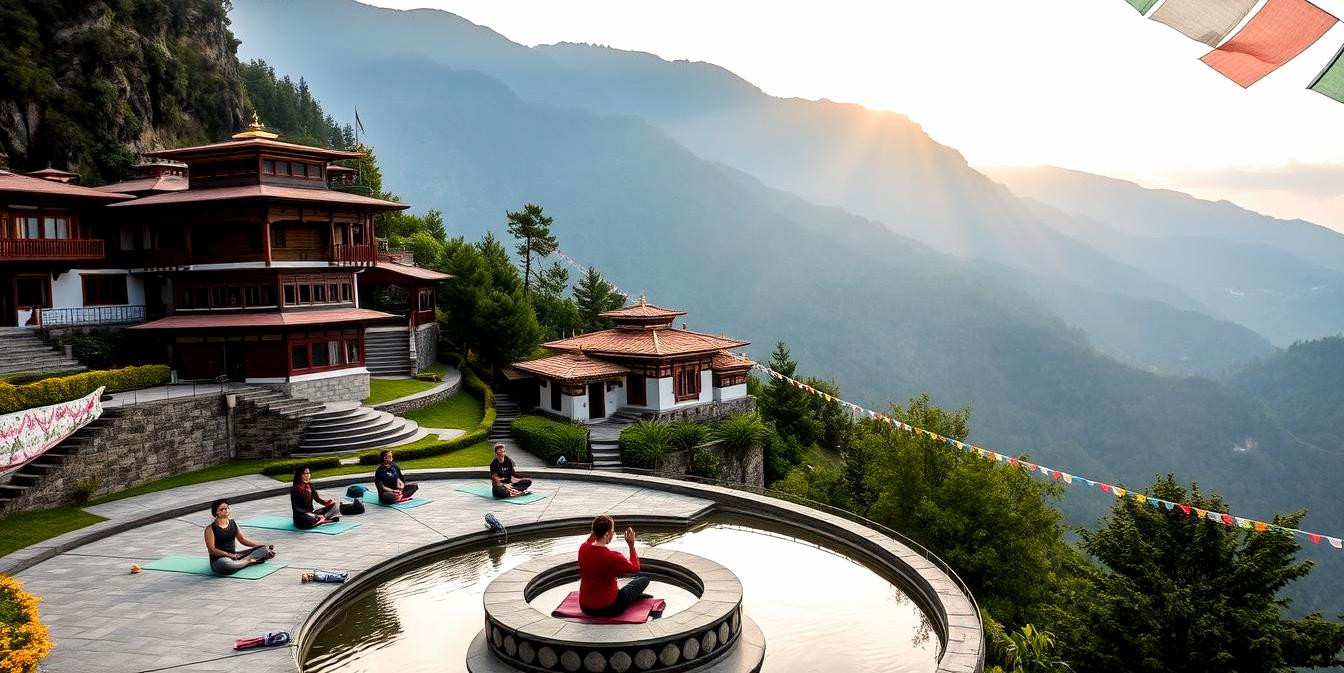
Spiritual Retreats
Buddhist Teachings and Meditation: Bhutan's Buddhist heritage permeates every aspect of its culture, offering a serene backdrop for spiritual growth. Many retreats include teachings from Buddhist monks and guided meditation sessions in ancient monasteries such as Paro Taktsang (Tiger’s Nest) or Punakha Dzong. These sessions help individuals develop mindfulness and a deeper understanding of Buddhist philosophy.
Monastic Stays: Some retreats offer stays in monasteries, allowing participants to live alongside monks, observe their daily routines, and participate in meditation and prayer. This immersive experience provides a unique insight into the spiritual practices that are central to Bhutanese life.
Wellness Retreats
-
Yoga and Meditation: Combining the physical aspects of yoga with Bhutan's peaceful environment enhances both mental and physical well-being. Retreats often take place in tranquil locations surrounded by nature, further aiding relaxation and reflection.
-
Traditional Bhutanese Medicine: Inspired by Buddhist principles and integrated with Tibetan and Indian practices, traditional Bhutanese medicine uses natural herbs, acupuncture, and moxibustion to treat various ailments. Many wellness retreats include consultations with traditional healers, offering a holistic approach to health.
Nature Therapy
-
Forest Bathing: Inspired by the Japanese practice of Shinrin-yoku, forest bathing in Bhutan involves spending time in the lush, green forests to absorb the forest atmosphere, which is believed to reduce stress, improve mood, and boost the immune system.
-
Thermal Springs: Known locally as Tshachus, Bhutan’s hot springs are popular for their therapeutic properties. These natural springs are scattered throughout the country, and visiting them is considered both a pilgrimage and a method to rejuvenate and heal the body.
Integrative Wellness Programs
-
Tailored Retreats: Recognizing that wellness is not a one-size-fits-all solution, many Bhutanese retreats offer programs tailored to individual needs. These programs combine physical activities like hiking and biking with spiritual and wellness practices, ensuring a balanced approach to health.
-
Cultural Immersion: Part of the wellness experience in Bhutan involves engaging with the local culture. This includes learning about local crafts, Bhutanese cuisine, and traditional dance, activities that foster a deeper connection to the land and its people.
Environmentally Conscious Retreats
- Bhutan's commitment to environmental conservation extends to its wellness and spiritual retreats, which operate under the principles of sustainability. This ensures that the retreats not only provide benefits to the participants but also contribute positively to the environment and local communities.
Bhutan's spiritual and wellness retreats offer more than just relaxation; they provide transformative experiences that integrate physical health, mental well-being, and spiritual enlightenment. This holistic approach, set against the backdrop of Bhutan's stunning natural beauty and rich cultural landscape, makes the country a unique destination for those seeking to recharge and reconnect with themselves.
Natural beauty, great culture, and profound spirituality all combine uniquely in Bhutan. Bhutan offers a trip that transcends the usual—from the stunning Himalayan scenery and quiet refuges to active celebrations and special food. Every trip adds to cultural protection and conservation given our deep respect for sustainability. Relax Getaways lets you discover the unmissable attractions of Bhutan, where every trip offers enrichment, excitement, and a closer contact with oneself and nature.
FAQs for Highlights of Bhutan
Q: What is the best time to visit Bhutan?
A: The best times to visit Bhutan are during the spring (March to May) and autumn (September to November) when the weather is pleasant, skies are clear for mountain views, and vibrant festivals take place.
Q: What are the must-see festivals in Bhutan?
A: Key festivals to attend are the Paro Tshechu and Thimphu Tshechu, which feature colorful dances, traditional music, and elaborate cultural displays. These festivals offer deep insights into Bhutanese culture and traditions.
Q: What are some popular trekking routes in Bhutan?
A: Notable trekking routes include the Jomolhari Trek, with stunning mountain views, and the Druk Path Trek, known for its scenic beauty and cultural sites. The challenging Snowman Trek is also popular among experienced trekkers.
Q: Can I explore Bhutan independently?
A: Independent travel is not permitted in Bhutan for most international tourists. All visitors (except citizens of India, Bangladesh, and the Maldives) must have their trips planned and arranged through a licensed Bhutanese tour operator.
Q: What are some traditional dishes I should try in Bhutan?
A: Try Ema Datshi, the national dish made with chili and cheese. Other traditional dishes include Phaksha Paa (pork with red chilies) and Jasha Maroo (spicy chicken stew). Bhutanese cuisine is notable for its bold flavors and extensive use of chilies.
Q: How does Bhutan promote sustainable tourism?
A: Bhutan adheres to a "High Value, Low Impact" tourism policy that includes a minimum daily fee covering sustainable development contributions, services, and cultural preservation efforts. This policy helps maintain Bhutan’s environmental and cultural integrity.
Q: What should I pack for a trip to Bhutan?
A: Pack layers for variable weather, including warm clothing, a rain jacket, comfortable hiking boots, a hat, sunscreen, and a camera. Also, bring formal attire for visiting monasteries or dzongs.
Q: Are there any specific cultural etiquettes I should be aware of?
A: When visiting religious sites, dress conservatively and remove your shoes before entering. It is polite to refuse food once or twice before accepting it, and always use your right hand or both hands to give or receive items.
For detail on Nepal Tour.
If you are looking for different kinds of Nepal Packages, feel free to contact us.
